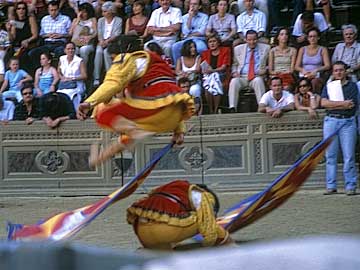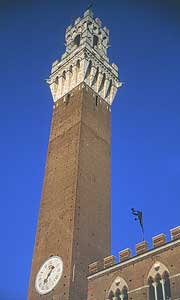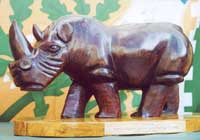An Italian Horse Race, Vassar, and a Rhinoceros
The first-ever Palio was held over 600 years ago in Siena, Italy’s shell-shaped Piazza del Campo. Crowds of people flocked to the city’s center — as they do to this day — for the event. Despite its long and colorful history, the celebrated horse race remains somewhat of a mystery to those outside of Siena. But those connected with Vassar can now become more familiar with its tradition.

Flag bearers from the contrada Chiocciola perform during the pre-race parade.
Twice a year, the Palio gathers the entire city to pit neighbor against neighbor. Central to the event are Siena’s 17 contrade — neighborhoods that were originally defined in the Middle Ages to aid in the city’s defense. While the contrade no longer play an administrative role for the city, they are still bound by the devotion, competitiveness, and emotions of their inhabitants. All important events in any contrada — baptisms, deaths, marriages, festivals — are celebrated by, and only by, residents of that contrada.

The Bell Tower in the Piazza del Campo, Siena, Italy.
Naturally, this loyalty extends to the horse race. Each contrada has a museum, a chapel, and a casa del cavallo. The latter, literally translated as "house for the horse," is indeed what it claims: a house rather than a stable. The horse assigned to each contrada is highly respected and honored. As Vassar’s Associate Professor of Italian Eugenio Giusti explained, "Before the race, the horse is brought into the chapel, where it is blessed by a priest. If the horse leaves droppings, this is taken as an extremely lucky sign." Wearing the colors and emblem of the contrada it represents, the horse then circles the Piazza del Campo three times at breakneck speed, with or without a jockey. (Often jockeys are thrown during the race, but a horse is still allowed to race and win when cavallo scosso, bareback.) That a 90-second race requires such planning and receives so much attention exemplifies the loyalty and devotion the Sienese feel for their contrada.
A contrada’s museum chronicles its history with past victory banners (il palio), sculptures, paintings, and exhibits. Access to the museums is strictly limited. Italians must write a letter petitioning entrance, and foreigners are rarely allowed in unless through a personal connection. The 17 emblems of the contrade include the tortoise, wave, she-wolf, goose, shell, porcupine, dragon, owl, snail, panther, eagle, caterpillar, unicorn, ram, giraffe, tower, and forest. It is in the forest that Vassar has its connection to the Palio.
In 1997 Vassar debuted its Summer Program in Siena. In exchange for hosting up to 20 intermediate Italian-language students for four weeks, the University of Siena sends one graduate fellow to research, teach, and study at Vassar for one year. To support the program, Professor Giusti and Visiting Assistant Professor of Italian Roberta Antognini received a Mellon grant to create supplemental materials, including a Website (http://andiamo.vassar.edu) offering a virtual trip to Siena and a video highlighting the cities of Siena, Bologna, Venice, and Rome. "The purpose of the Website and the video are to aid first-year Italian students in studying the geography, culture, and linguistics of Italy," Giusti said. "In each city, we looked for a connection that would open up a part of the city that is not usually available to foreigners."
When it came time to film in Siena, the obvious highlight was the Palio with its unique history and traditions. Using the strength of the Summer Program’s success, Giusti approached Laura Biagi, Vassar’s first visiting language fellow from Siena.

Crowds watch as each contrada's entourage parades through the streets.
In 1997 Biagi’s father, Mario, a member of the council for the Selva contrada, allowed the Vassar students and professors into the contrada’s museum and chapel. Through his continued relationship with the Biagi family, Giusti learned that Selva’s museum was completely renovated in 2000. Without hesitation, Mario Biagi again opened up the museum to Vassar — this time accompanied by a film crew. Today, members of the Vassar College community are able to tour the museum when visiting Siena, after first making an appointment with the museum’s guardian. (Contact eugiusti@vassar.edu for more information.)
For this invitation into a normally private community space, Vassar searched for a way to say grazie. Although Selva is translated as "forest" or "thicket," its logo depicts a rhinoceros with an oak tree on top. After viewing various representations of the emblem in the Selva museum, the Vassar Italian department decided to contribute a sculpted rhinoceros to the collection. Through a friend and collector of African art, Giusti found an African statue of a rhinoceros hand-carved out of ironwood — a heavy, mahogany-colored wood similar to teak — by the ’Ngoni, part of the Zulu tribe in Malawi. The piece stands on a base that resembles the African savanna and carries a gold plaque that reads "Dono del Dipartimento di Italiano di Vassar College, August 2001."

Photo by Mike Fabius '04.
